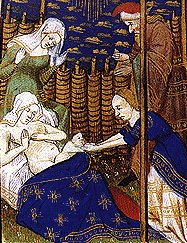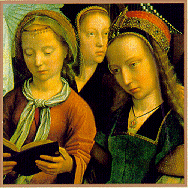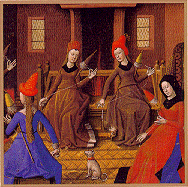Anglo-Saxon literature was based on Germanic myths about battles, heroes, diseases, dragons and religion. Writers did not pay much attention to female issues, and there are only few poems that talk about them. 
Marriage meant very much to women particularly for their status and economic security. In the medieval era, people wed within their class and only a slave could sometimes find his match and marry for true love. Wars and family feuds forced females to play the role of peace-weavers. They were often married to their family’s enemy to make a truce between warring tribes. The poem “The Wife’s Lament” is about a woman who, at one time, apparently, was a peace-weaver. The wife and her husband are separated against her will; she feels very unhappy and lonely. The husband has committed a murder and then has abandoned her: “I am overcome with longing. These dales are dark, and hills high, bitter bulwarks ever grown with briers, a joyless dwelling. Here very often my lord’s going away has wrenched me” (102). In Anglo-Saxon England, a marriage did not mean happiness or love. It put women in a very tough position since they had to assume the role of peace-weavers and to unite two families that hated one another.
In many cases men treated women as sexual objects and did not respect them. 
On the other hand, in the kingdom the king respected his queen and she played an important role. In the poem Beowulf, Wealhtheow is a Danish queen and Hrothgar’s wife. She is mentioned as Hrothgar’s lover and sexual partner: “The lord of the Shieldings, their shelter in war, left the mead-hall to lie with Wealhtheow, his queen and bedmate”(46). In the hall, Wealhtheow serves alcoholic drinks to all the guests (only women were allowed to serve alcohol). She is a cup-bearer during the celebration: “So the Helming woman went on her rounds, queenly and dignified, decked out in rings, offering the goblet to all ranks” (45). Since women were meant to stay out of trouble, they never got an opportunity to learn how to defend themselves. When Beowulf dies, one Geat woman screams in grief, and she fears the coming slavery. Beowulf’s tribe will be overtaken once the leader dies, and enemies will enslave his people (99). This woman has no idea how to protect herself and is left only with grief. Anglo-Saxon literature is mainly about wars, heroes and Christianity. 
There are not many works that focus on the lives of women who were usually looked upon as lower class. Women were considered as objects that could be manipulated in any way by men. In the medieval era, it was common for female to be unrecognized and undervalued. Women’s social position was at the bottom of the scale; they were forced into an arranged marriage and they had abusive husbands on whom they were completely dependent. The medieval era was not a great time for women. Unfortunately their situation worsened with the year 1066 and the Norman Conquest. New laws only brought a further negative impact on women’s position in society.